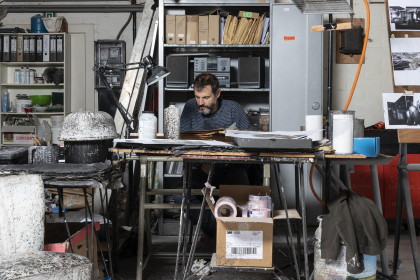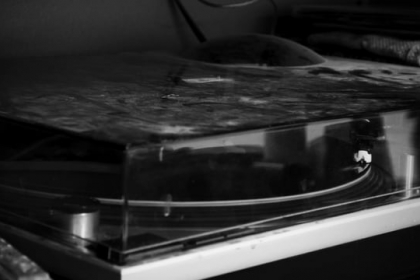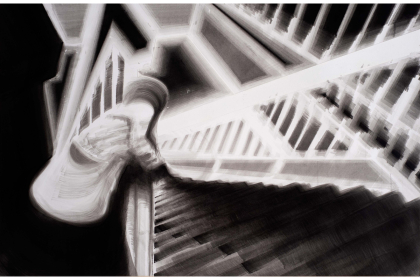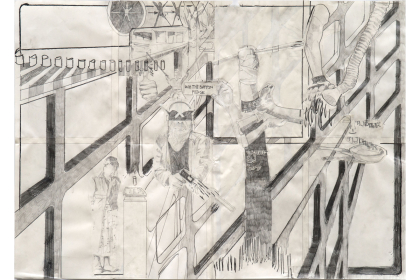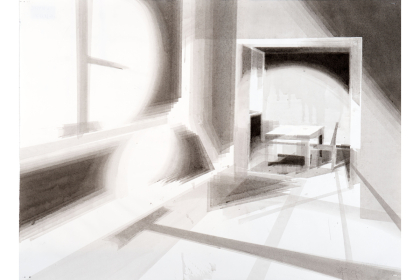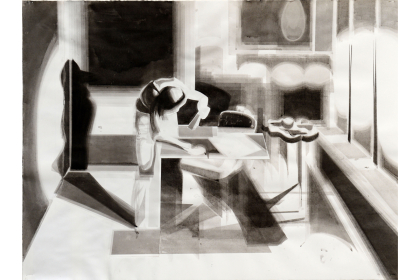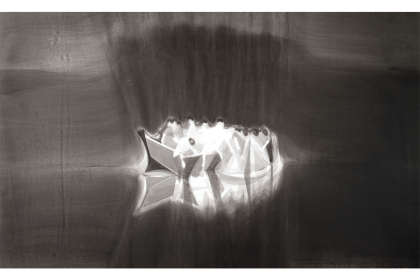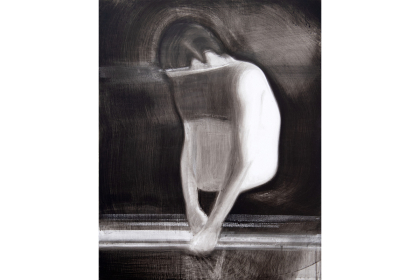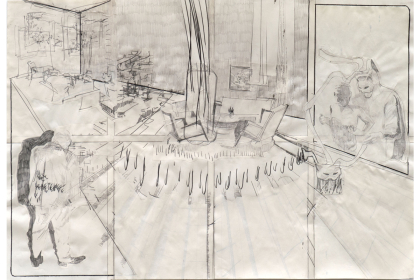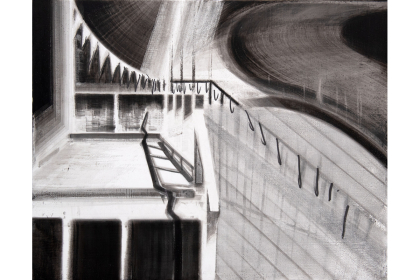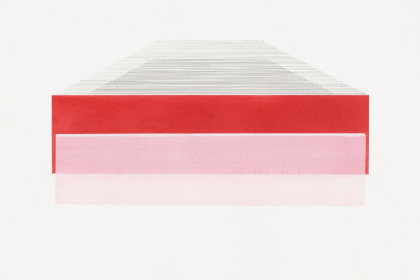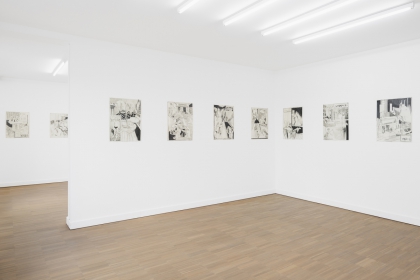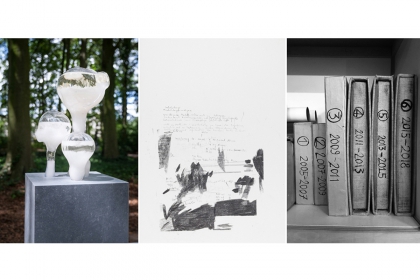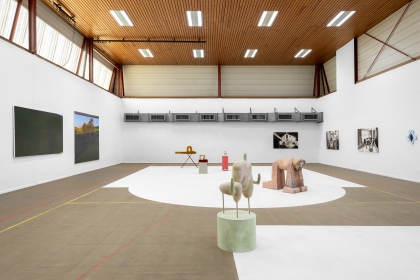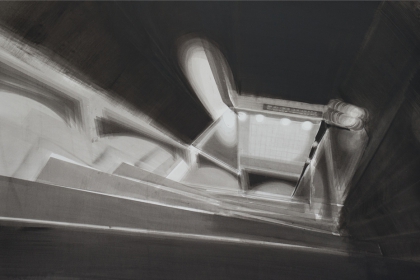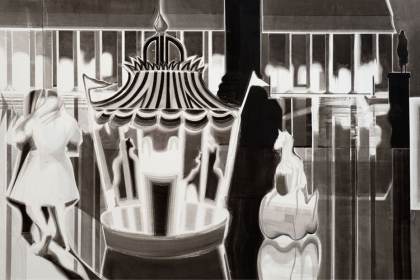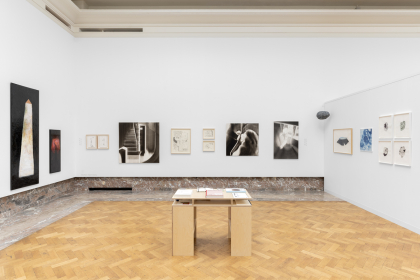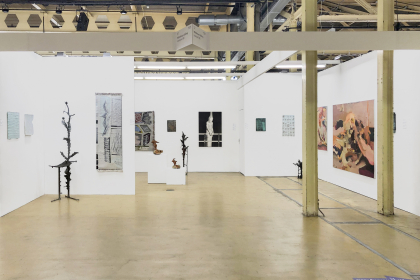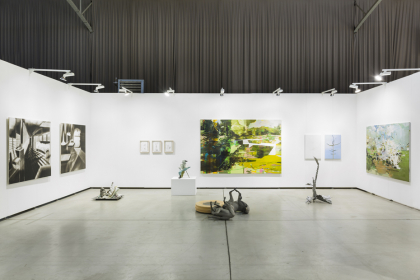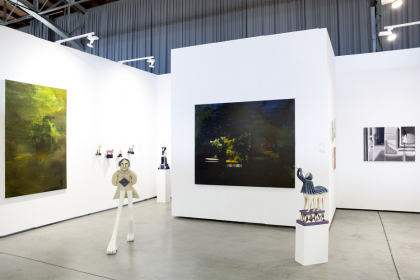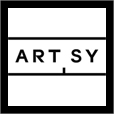Stefan Serneels (1968, Antwerp)
Lives & works in Aarschot (BE)
Video: Jan Weynants
Drawn Panorama: the psychopictorial aspect in the oeuvre of Serneels
A text occasioned by interviews with Stefan Serneels
The source material for Serneels’ works of art consists of combined fragments from film stills, documentaries, photography, old magazines and digital images. In this way, a kind of assembling already arises in the primary sources for the work. Bringing together various snatches, often details, is the first trail in the quest for a synthesis in the construction of his work of art. Serneels is an artist who does not trace recycled images, but uses them as an impulse for the layout of his images, as the transcendence of the formal idiom from a hermeneutic point of view, so as to generate a new frame of interpretation. The direct recognizability of certain movies is often avoided. The mysterious dimension arises by selecting less explicit and referential scenes. They function then as a guideline for a specific filmic atmosphere and are never completely recuperated. His intuition determines which image eventually will serve as the basis for a work of art. Even though Serneels uses very diverse photographic images, one sees that various elements always recur. There is a kind of recognizability of successive resemblances. In this way, various perspectives, stairs, objects and middle-class interiors are repeated in very diverse works. They are often inspired by similar scene tension elements from specific film genres. The film stills then are only the impulse to the work of art and finally get their unique shape in the free sketch.
The multidisciplinary oeuvre of Serneels does not limit itself to mere drawing. The sculptures, short films, cartoons, installations, murals, drawing paintings and pure drawings influence one another. Yet, Serneels has a fondness for figurative draughtsmanship, where he embraces classic discernible figuration. The panoramic drawings enable him to reach out from the compression of the surface of the page, which is often too limited. There he can completely break through the phenomenon of less is more. By way of the panorama the freedom arises to bring together very diverse fragments. The mutual cohesions come into being as self-evident. They are a kind of abstract narrative relationships that in a way become joined with comics and the graphic novel. Working from a far-reaching intuition gives him the inspiration to deviate from illustrations, focussing on the free coming into being of the narrative world. By repeating certain forms, meaning is generated. The alienation in his work takes shape in the quest for a combination of coincidences. It is most certainly not a coincidence that the free associations from the long drawings, such as his sketch books, give material that can be recycled for diverse, more individual drawings. The specific use of black ink in the work of Serneels occurs more from an aesthetic point of view.
Sven Vanderstichelen
Surrealism as the madness of banality
The mysterious works of the Belgian artist Stefan Serneels seem to perceive the everyday life, however recognizable, in a highly personal manner, as in the loneliness of insanity. In his drawings and paintings for example Serneels establishes unusual connections between elements that are on their own ordinary, suggesting an unknown individual experience. His surrealistic style is averse to frivolity. Like in the work of Neo Rauch it remains pointedly serene, which for example stems from the depressed body language and facial expressions of the depicted characters. Absurdity is taken seriously in Serneels’ work, so that it all the more evokes a feeling of alienation.
As a result the everyday scenes gain an almost theatrical weightiness, which reminds you of the play The Homecoming of Harold Pinter, where a creepy atmosphere is created in the most domestic environment. In Serneels’ series of paintings The Hikikimori studies (2007) ‘hikikimori’ for instance refers to a Japanese phenomenon where young persons choose to lead a hermit’s life. In all their banality the living rooms in these paintings particularly create the impression that something is not right.
Because the furniture and the wallpaper for example have a ‘grantparental’ style and the works are mostly painted in black-and-white, a certain melancholy is evoked. Most strikingly however, this feeling occurs as a kind of intangible recognition, where the logic of the domestic is subverted. On the one hand recognizable matters seem to lose there everyday meaning as they are deformed and intermingled. On the other hand some trivial forms or objects, like a black spot, a straw or a cactus, precisely seem to gain a special meaning, when the characters pay attention to them or when they are depicted several times. As a spectator you do not have insight into this special meaning. The isolation and insanity of the ‘hikikimori’ are expressed by the suggestion of an incomprehensible logic. Like the evident is contrasted with the unintelligible, so is, stylistically, the beautiful, the complete opposed to chaos. Among figurative forms unrecognizably abstracted forms are placed, which underline the irrational threat expressed in the work.
Serneels also made a short film on the subject of ‘hikikimori’, named Hikikimori style (2007). Here we see a character who again isolates himself in an outmoded room. He spends his time with, among other things, stamping a book using ink and a piece of potato. As pieces are cut from the film and the actions of the character rhythmically ‘jump’ to the most essential parts, their ritual meaninglessness becomes even more striking and even humorous. The threat of insanity and isolation is sought by Serneels in the absurdity of the ordinary but is at the same time being countered by it and made more light-hearted.
When the character ends up in another dimension through a hole in his mattress, he still cannot escape from his ordinary existence. From this other world he returns with only a wrapped up human figure, to which he cannot relate and which turns out to be nothing more than an insignificant object. He stamps the figure many times with a piece of potato, just like his book, after which he finally puts it away in his mattress again. Because Hikikimori style is in the strict sense a story without a point, it demonstrates that when you cannot find any significance to life, only the logic of the ritual remains.
Serneels’ work emphasizes that a personal experience is unique because it cannot be precisely shared with others, but also because it cannot be precisely repeated or remembered. Especially his sculptures bring attention to this. In Restpiece 2 (2001-2002) a replica of a mattress is hung to the ceiling with ropes. While nothing remains of the mattress itself, its copy, which consists of white clay, has crossed to a colder, more ‘bathroom-like’ atmosphere. A hole in the mattress replica and the whitely stained bedstead beneath it suggest that an event has taken place. It seems that a sleeping person, maybe in a dream, has fallen through his mattress. But if this ‘decomposed’ bed portrays a dream state, it has nothing magical. If the sleeping person has had a meaningful experience, then the sculpture can only suggest this vaguely, like a memory of a dream. The only actual thing that remains is trivial reality.
Also the sculpture Interior piece II creates the suggestion of what has been lost. On an old-fashioned coffee table a full ashtray and a playing radio are put. One of the table-legs, the ashtray and a lamp hanging above the radio are made of frozen ink, which slowly melts, so that the original setting is gradually destroyed and soiled with black stains. In this manner we see a staged hominess being lost and the melancholy of an outdated style transform into a gothic atmosphere. The loss of recognizable objects from the past suggests that you cannot hold on to a moment despite the souvenirs it leaves you with.
The thing that the diverse works of Stefan Serneels may have in common the most is the melancholy and poetry of a lost purpose. In fact they are comparable to an attic: objects and atmospheres from forgotten times are thrown together in an absurd manner, as in a dream that remains a mystery and that you do not do anything with. While the intermingled elements partly evoke their old context, their new context is that of uselessness. Just like an attic the works of Serneels also raise a certain fear, which does not have a concrete object and is again dream-like. But because of that absurdity it is pure and universal. If even the sense of security of a home cannot be communicated, then Serneels’ works do convey precisely the creepiness of this given.
Matthias Van de Vel

